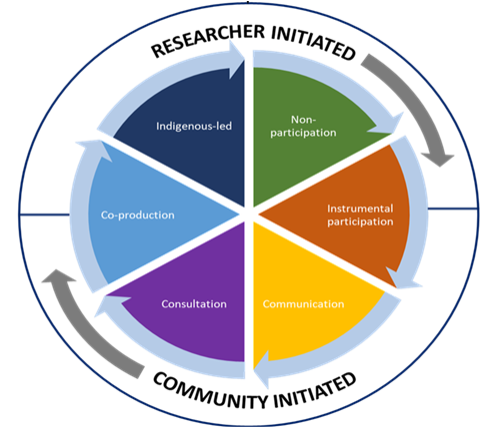Levels of Collaboration in Indigenous-Engaged Research
There are several ways to engage with Native American communities in doing research, ranging from less to more collaborative models. Often, when people think of Native-engaged research, they think of research that is ‘on’ or about Native peoples–research in which Native peoples are the research subjects rather than agents in the research process. Most often, this type of research would fall under the research type of ‘non-engagement’. Researchers may need to ask themselves why they are wanting to do research about Native communities/peoples to determine which type of participation is appropriate.
Levels of Community Engagement in Tribal-University Research

While co-production and Indigenous-led are often held as the standard within the discourses calling for decolonizing research (Lightfoot 2017), which model is appropriate to a particular research context depends on the needs, wants, and capacities of the Native Nations engaged. A Native Nation may have the capacity and infrastructure to lead a research project in which university researchers provide support. Other Native Nations may want to guide the questions being researched but, due to limits in infrastructure, personnel, or experience, may want the researchers to design and conduct the project. Regardless, researchers need to let the community lead in making these decisions. Native Nations and their citizens have rights, including the right to be involved in making decisions that impact their communities.
Native-engaged research about Native peoples, however, even when on the low end of the collaboration scale, can be meaningful and done ethically, but only if researchers are engaging with Native communities first to determine whether the community is interested in participating in the research, the research question is of value to the community, and the methods are consistent with the community’s values/norms. Research design that engages Native Nations citizens in supporting the research may fall somewhere closer to instrumental participation. At the very least, there should be some meaningful communication and approvals by the Native Nation or Native Nation personnel, as appropriate to the context.
Moving further toward more full collaboration in research, the consultation model entails researchers receiving guidance from citizens or community members in development of research questions, methods, and/or framing. This may mean submitting a proposal to a Tribal Institutional Review Board or equivalent, working with a department, but seeking Tribal Council approval, or seeking feedback on how to meaningfully revise a proposal so that it more closely aligns with the community’s needs. On the most collaborative end of this spectrum are the co-production model (Ostrom 1996), where Native and university researchers work in partnership throughout the research process, from generating the research question to co-authorship in publication, and the Indigenous-led model (Austin 2019, Latulippe and Klenk 2020), where the Native Nation or Tribal citizens conduct the research, from design to publication, themselves with support from university personnel.
While co-production and Indigenous-led are often held as the standard within the discourses calling for decolonizing research (Lightfoot 2017), which model is appropriate to a particular research context depends on the needs, wants, and capacities of the Native Nations engaged. A Native Nation may have the capacity and infrastructure to lead a research project in which university researchers provide support. Other Native Nations may want to guide the questions being researched but, due to limits in infrastructure, personnel, or experience, may want the researchers to design and conduct the project. Regardless, researchers need to let the community lead in making these decisions. Native Nations and their citizens have rights, including the right to be involved in making decisions that impact their communities.
Engaging Native communities throughout the research process has benefits for both Native Nations and for university researchers. Collaborative research can increase the likelihood that projects address key community challenges, inform decision making within the community, and improve environmental and social outcomes (Bassler et al. 2008), as well as increase the likelihood of uptake of the project findings and suggestions (Begay, Cornell & Kalt 1998). Collaborative research further empowers Native communities, integrates multiple perspectives, creates opportunities for discussing concerns and mutual learning, and can support increased trust in universities, community organizations and governance (Herkshan et al. under review). Finally, collaborative research supports Tribal Sovereignty and capacity building by respecting Native research sovereignty, the right to decide what research occurs within the community, how it is conducted and framed, and how results are disseminated.
Learning About Community-Specific Values
In addition to understanding and engaging with best practices in collaborative research, researchers new to working with a Native nation may need to spend some time learning about the specific values and culturally-appropriate practice of that community. For example, in many Native nations, it is customary to offer a gift when asking for information or time from an individual, especially an elder. What gifts would be appropriate depend on the specific community. In addition, there may be differences in values and norms concerning time frames for work, communication (collectively focused or individually focused), and relationship-building. While it is best practice to learn specifically about the Native nation with which you hope to work, a good place to start for a general framework might be the Six ‘R’s of Indigenous research: Respect, Relationship, Relevance, Reciprocity, Responsibility, and Representation (Tsosie et al., 2022).